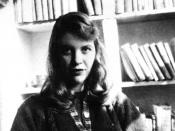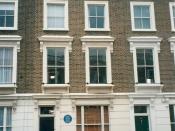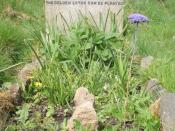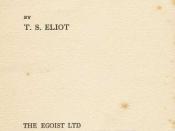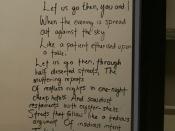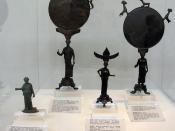The poem ÃÂMirrorÃÂ by Sylvia Plath explores many concepts, including self-discovery and identity. The mirror lives within the poet and is personified to speak its thoughts and understanding of the world around it. ÃÂIÃÂ amÃÂ exact. I have no preconceptionsÃÂ. This truthful mirroring is devastating to the woman when she honestly confronts her image. Only the mirror refects truth, which is her aging self, her pain. The persona in this poem could have represented society at the time, a shallow society persistent on looks and beauty and not focused on the inner beauty of women. There was a misconception that, as people age, they become uglier, and that a womanÃÂs worth and identity are based on her looks.
ÃÂMirrorÃÂ by Sylvia Plath shares distinct connections in themes and ideas in terms of identity with T.S ElliotÃÂs ÃÂThe Love Song of J.Alfred PrufrockÃÂ. The insecurity of the woman persona in ÃÂMirrorÃÂ is identical to the inadequacy and self-consciousness of Prufrock.
Both personas are very conscious of their physical appearance and believe that their looks make up their identity to society. The woman cries in front of her mirror and describes herself as a ÃÂterrible fishÃÂ as she dawns to the truth that she is aging. Prufrock is plagued by doubts about his stature and physical appearance ÃÂ bald spot, his thin legs, and his dress. There is an underlying fear of growing old for both personas. ÃÂI grow old...I grow old...ÃÂThe Mirror serves as a tool to escape the lies and misconceptions of society and reveal only the truth, albeit dissatisfying. ÃÂI am not cruel, only truthfulÃÂ. Similarly, Prufrock resides in a trivial society condemned to aimless conversations of ÃÂMichelangeloÃÂ. Prufrock has self-knowledge that allows him to see life through a different light and is aware that there is a more meaningful society. ÃÂFor I have known them all alreadyÃÂ. But his own cowardice and self-questioning prevents himself from bringing change to his tedious life ÃÂmeasured out in coffee spoonsÃÂ. ÃÂDo I dare disturb the universe?ÃÂTechniques used in ÃÂMirrorÃÂ includes personification and imagery effectively to further convey meaning. Personification of the mirror is used to present the identity of the young woman from the point of view of a mirror. ÃÂI am silverÃÂ; ÃÂI meditate on the opposite wall. It is pink with speckles.ÃÂ The use of ÃÂspecklesÃÂ represents imperfections, which emphasises that the mirror does not alter its perceptions, and gives a justification, ÃÂI am not cruel. Only truthfulÃÂ. The separation of the two stanzas also serves as a purpose to separate time. In the 2nd stanza, the identity of the persona (young girl) has changed into an older woman, which represents the next stage of her life. Devices such as similes and metaphors are used elaborately to add further meaning to the imagery. ÃÂI am silver and exactÃÂ, ÃÂI am important to herÃÂ and ÃÂNow I am a lakeÃÂ. In the lake, she has ÃÂdrowned a young girlÃÂ her old self and will henceforth be an old woman, rising ÃÂtowards her day after day, like a terrible fishÃÂ. The simile of the ÃÂterrible fishÃÂ illustrates the fear that the woman attempts to avoid the inevitable loss of her inner beauty, following the loss of her physical beauty which reinforces her negative self-image.
bibliography: www.eliteskill.comwww.sylviaplathforum.com
